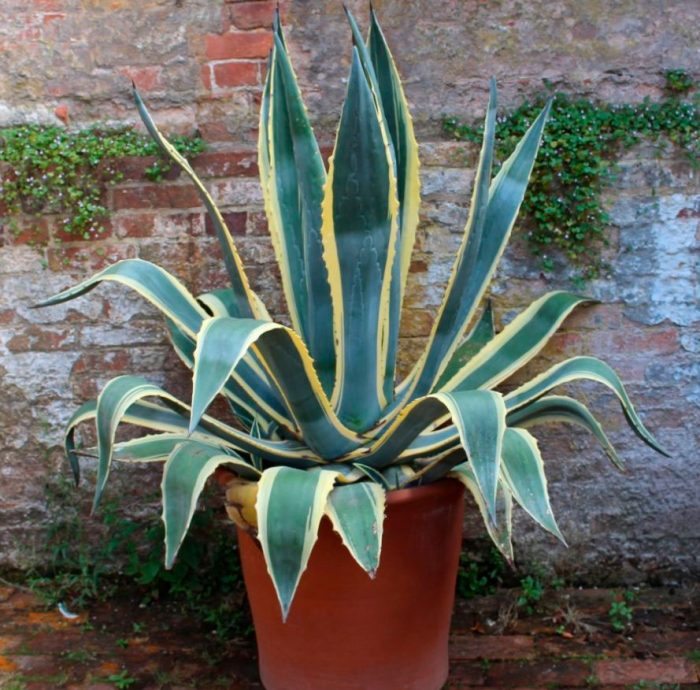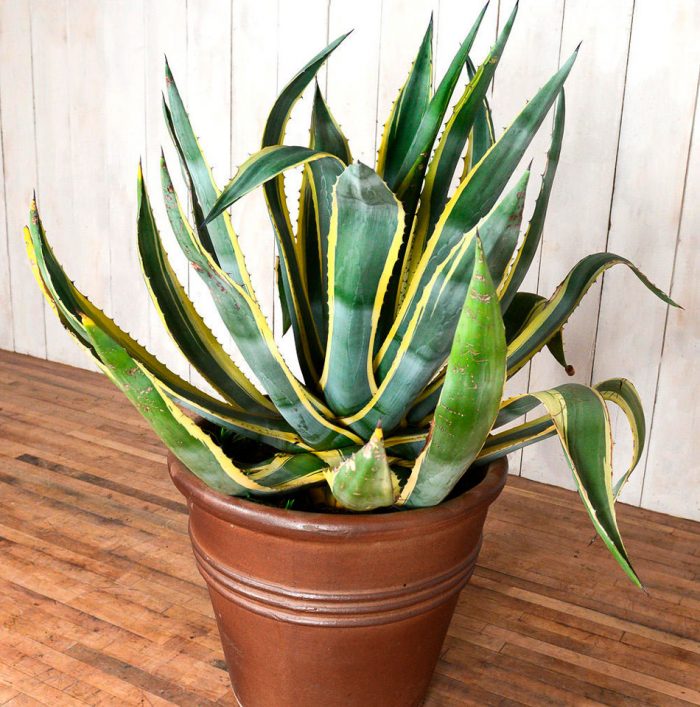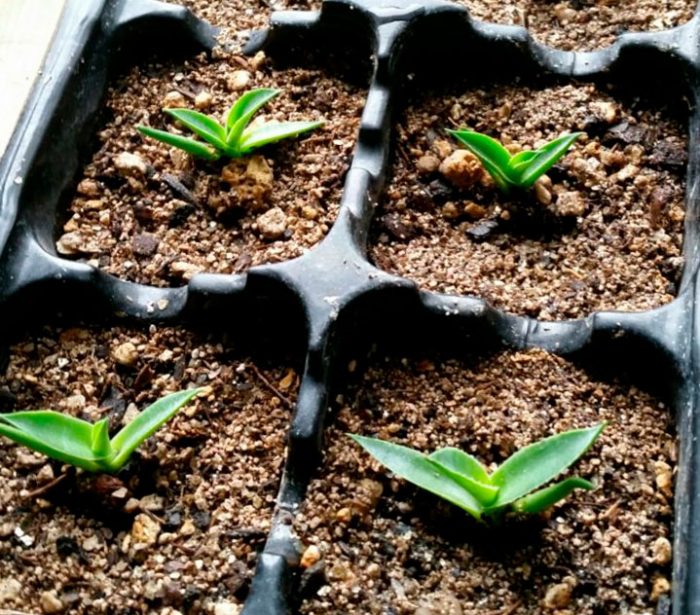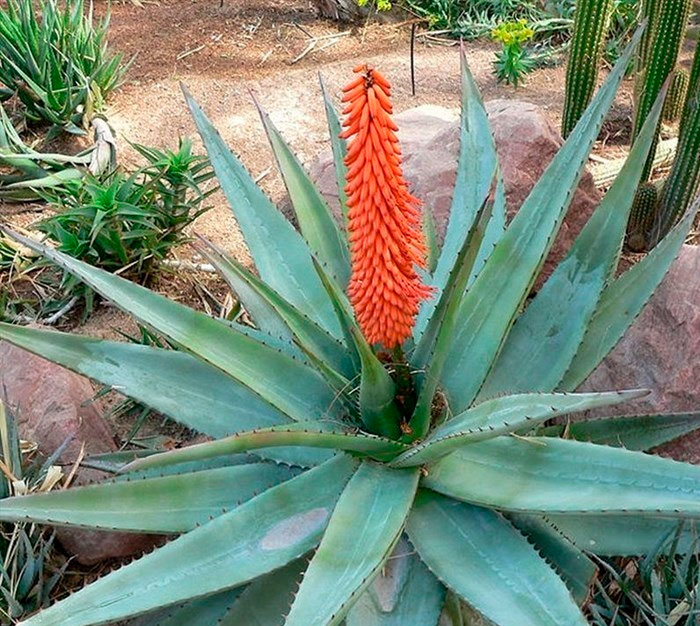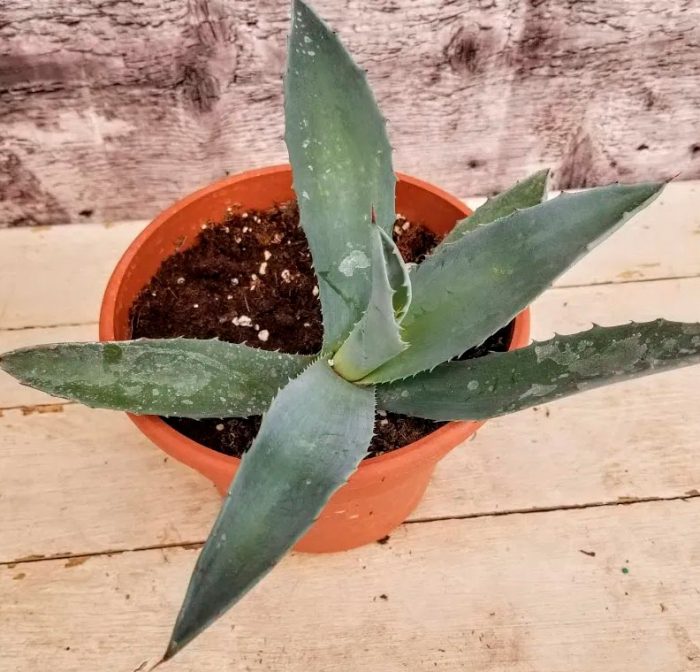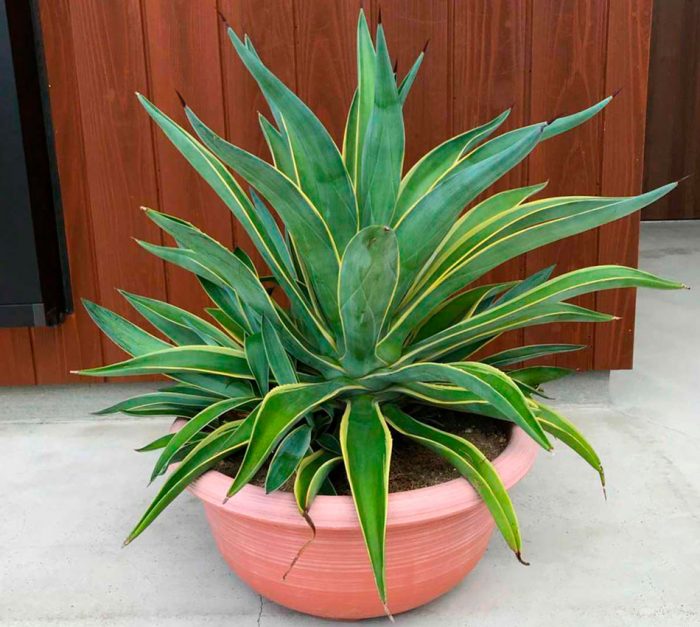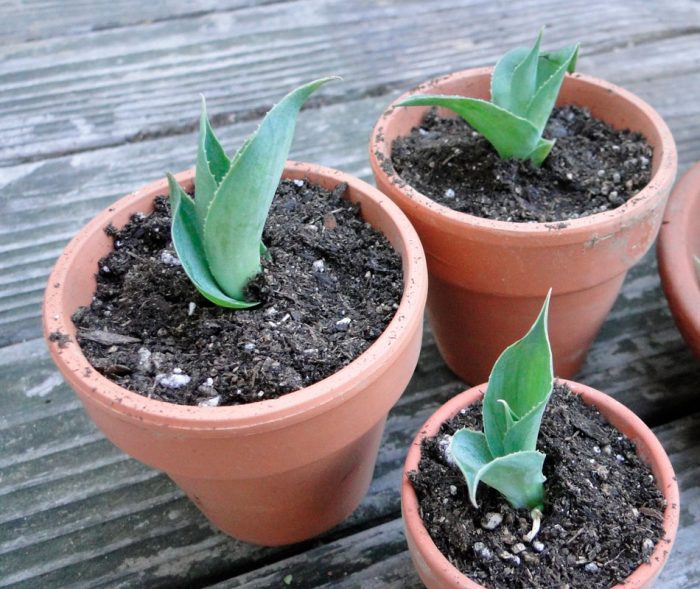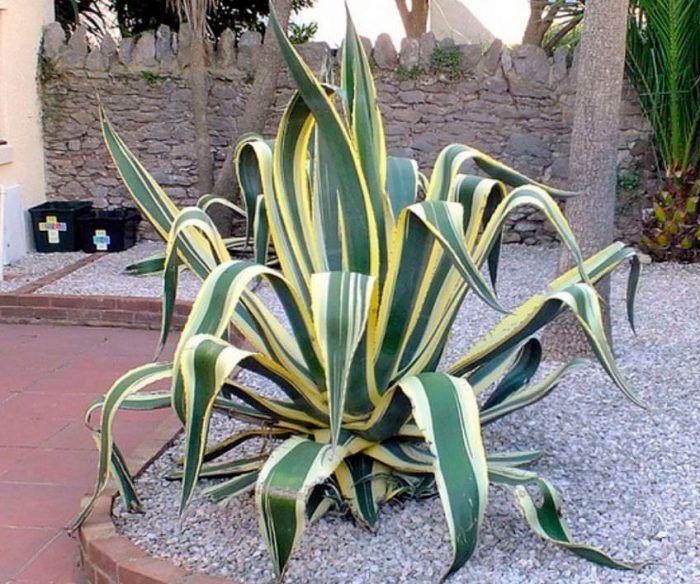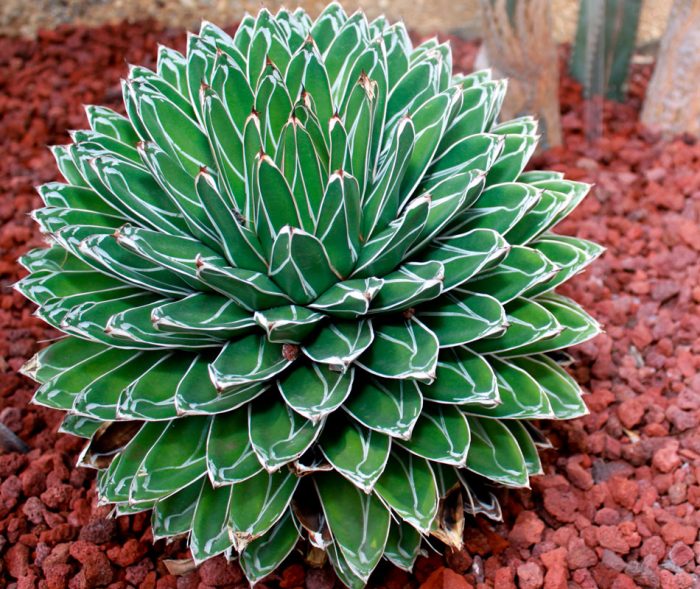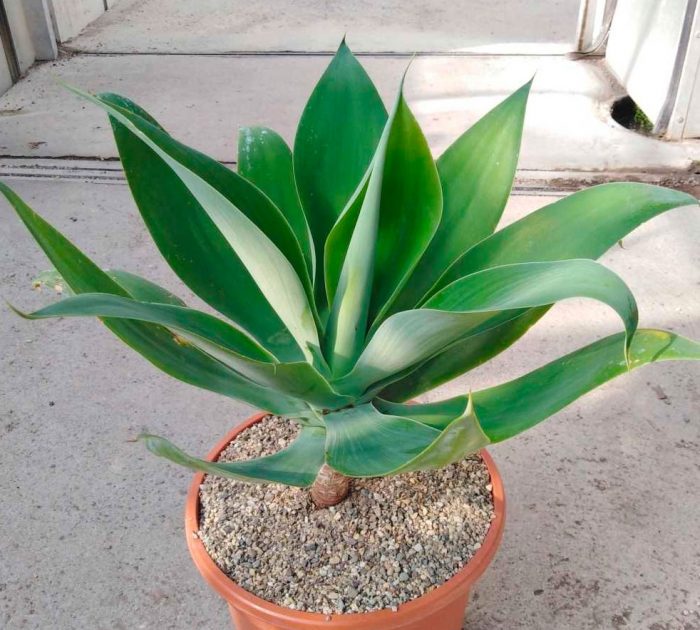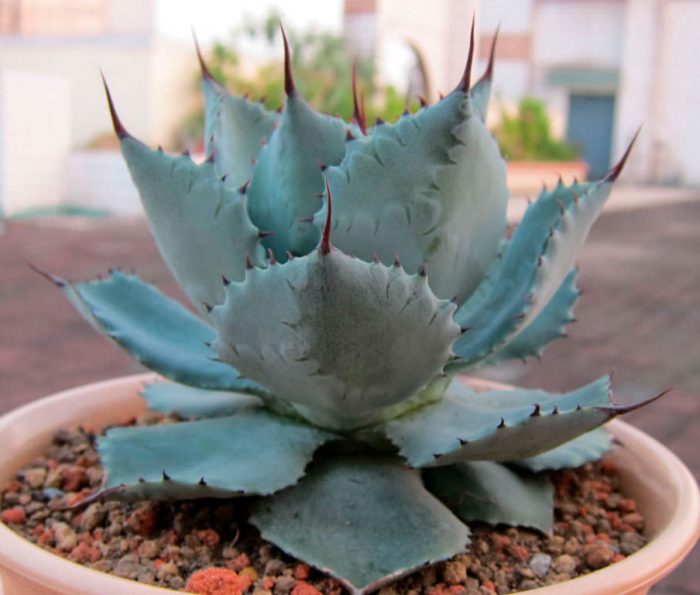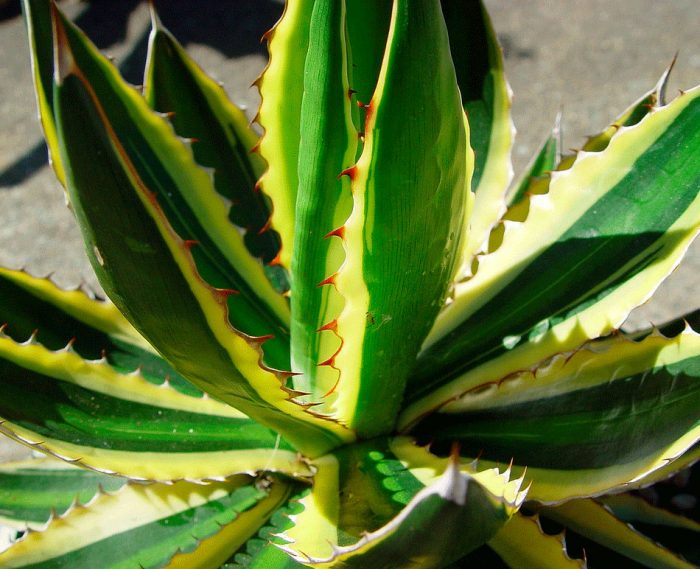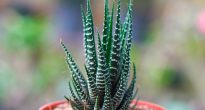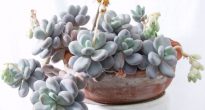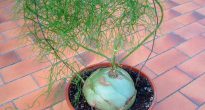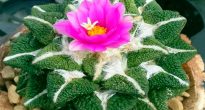The succulent plant agave (Agave) is a member of the Asparagus family and the Agave subfamily. This plant comes from Mexico, India, subtropics and tropics of North and South America. And also such a succulent can be found in the Mediterranean countries.
The size of the bush can be 0.3–2 meters (depending on the variety). Agave has an average growth rate and belongs to perennials. When grown indoors, it is extremely rare to see the flowering of this succulent and only in old bushes. Differs in undemanding care and growing conditions.
Content
Brief description of cultivation
- Temperature regime... In summer, the air temperature can vary from 16 to 29 degrees. In the cold season, the plant should be kept cool: from 10 to 17 degrees.
- Air humidity... The humidity level should be low.
- Illumination... The bush needs a lot of bright light, it is not harmed by the direct rays of the sun. That is why southern windows are best suited for him.
- Watering... The plant is drought tolerant. In the warm season, the flower is watered infrequently, and in winter this should be done even less often.
- Soil mixture... For agave, a purchased ready-made soil mixture is suitable, it should be well-drained, but weighted in composition. Be sure to add a little sand to it. To prepare the substrate with your own hands, you should combine coarse sand (or perlite), garden and leafy soil (humus) in a ratio of 3: 2: 2. A little bone meal, lime or egg shells should be added to the mixture. The finished substrate should have a pH of 6.8–7. The pot for planting is chosen such that there are drainage holes at the bottom.
- Top dressing... Fertilizers should be used in liquid form. Top dressing is carried out with a frequency of 1-2 times a month and only during the growing season.
- Transfer... Slow-growing varieties are transplanted once a year, and fast-growing ones - once every few months (if necessary). Each new container should be 30–40 mm larger than the old one. Adult bushes are subjected to this procedure once every 2 or 3 years.
- Reproduction... Most often, agave is propagated by offspring.They are planted in wet sand, regularly moistened with water from a sprayer, while being kept in partial shade. It is also grown from seeds, but in this case you have to be patient. Sowing seeds is carried out only in spring. Remember that some agave varieties can only be propagated by seed, such as Queen Victoria's agave.
- Care features... Variegated varieties are slow growing. Low-growing varieties can be grown hydroponically.
Agave care at home
Sowing
Not all agave varieties can be grown indoors. So be sure to make sure the plant you choose doesn't fall into this category. Most often, varieties such as small-flowered agave, filamentous and Queen Victoria are grown in room culture.
Sowing is carried out in February – March, while the seeds are planted to a depth of 0.5 to 1 centimeter. If you place the crops in a warm place (from 21 to 25 degrees), then the first seedlings should appear on the 5-7th day. First, the first leaf plate will appear, after about 15 days - the second, and after another 20 days - the third.
In a couple of weeks of growth, the bush reaches a height of about 80 millimeters, and up to 15 millimeters in diameter. Formation of the fourth true leaf plate occurs after another 20-30 days. At the same time, a leaf rosette should begin to form. In this case, the underground stem should reach a diameter of about 15 mm.
When replanting a bush, make sure that the root collar is not buried in the substrate. In this case, rot may appear on the sprout. In order to prevent decay, the root collar is sprinkled around with sand.
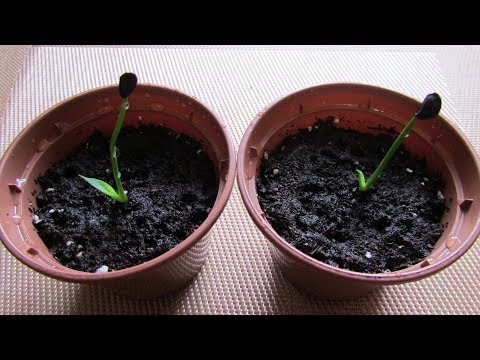

Watch this video on YouTube
Bloom
Indoor agave rarely blooms. During flowering, panicles are formed on the bush, consisting of many yellow flowers with a funnel-shaped shape.
In the wild, the plant blooms for the first time at 10-15 years of growth. When grown at home, as a rule, the bush begins to bloom only in 20-30 years of growth. After the agave has faded, it dies off completely, while a large number of root processes remain in its place.
Temperature
In the warm season, the optimal temperature for home agave is considered to be 20-28 degrees. At the same time, it may be hotter in the room, but it is impossible for the air temperature to be below 18 degrees. In the last autumn weeks, after reducing the daylight hours, the bush should be moved to a cooler place (about 10 degrees). Some varieties do well in a cooler place.
Air humidity
Low air humidity is best suited for growing this succulent, while additional moistening of the foliage from a spray bottle is not necessary. If you decide to transplant the bush into open ground in the warm season, then choose a place for it that will be reliably protected from precipitation.
Illumination
This flower needs a lot of bright light for normal growth and development. South, southeast and east orientation windows are best suited for it. While the bush is young and weak, it is recommended to shade it from the scorching rays of the sun, as they can leave burns on the foliage.
In winter, when the sunlight is not so bright and the daylight hours are short, the foliage of the agave can be very extended. Move the bush to the most illuminated place and, if necessary, provide it with illumination, for this use phytolamps.
Watering
From the first days of spring to the last days of autumn, this succulent plant should be watered regularly and in moderation. In the winter months, it is rarely watered, especially if the winter was frosty. Watering the flower must be very careful, as droplets of water entering the leaf outlet or sinuses can provoke rot.
To moisten the substrate in the pot, use well-settled water, the temperature of which should be slightly higher than room temperature. Once the growing season begins, the agave should be watered 2 or 3 times every 7 days. Moreover, the substrate is moistened only after its top layer dries out a little. It is not necessary to moisten the bush from the spray bottle.


Watch this video on YouTube
Pot selection
For this succulent, classic pots are suitable, the height and diameter of which are equal. When choosing the size of the pot, it should be borne in mind that in the first years of life, the root system of the bush grows very quickly. When a plant becomes an adult, the volume of its root system will increase extremely slowly. Therefore, in this case, the pot is selected such that its diameter is slightly larger than the diameter of the root system.
Earth mix
In nature, this succulent plant prefers to grow on rocky sandy soil. In this regard, it differs in undemanding to the substrate. In order to prepare the soil mixture with your own hands, it will be enough to combine coarse river sand, clay-sod soil and lime in a ratio of 1: 3: 1. It is also recommended to add 1 part of lime, charcoal or bone meal to the finished substrate. These ingredients not only saturate the substrate with nutrients, but also have a pronounced disinfecting property. Do not forget to make a good drainage layer at the bottom of the container.
Fertilizer
As a rule, feeding of room agave is carried out only during the growing season with a frequency of once every 2–4 weeks. In winter, feeding is not carried out. For this, a complex mineral fertilizer with a low nitrogen content is used. The fact is that if there is a lot of nitrogen in the substrate, then this can cause a weakening of the plant's immunity, as well as excessive growth of green mass. Experts advise using a special mineral fertilizer for cacti and succulent plants, which is sold in a specialized store.
Agave transplant
Transplant room agave only when necessary. For example, if the root system no longer fits into the pot. Adult bushes are subjected to this procedure once every two or three years. While the plant is young, it is transplanted every year, but do not forget that the new pot should be slightly larger than the old one. It should also be noted that the roots of young specimens grow quite actively. Such a flower is transplanted in the spring.
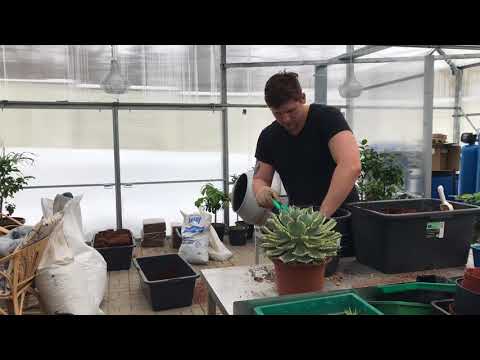

Watch this video on YouTube
Pruning
Homemade agave does not need pruning.
Dormant period
The resting period for such a succulent begins in the autumn and ends in the spring. During this time, the bush should be in a cool place (from 0 to 10 degrees). During cold wintering, the bush is not watered. However, if the temperature in the room is above normal, then the agave should be watered rarely and with a small amount of water, this will help to avoid overdrying the earthy coma.
Reproduction methods
Propagation of agave by offspring
During the growing season, offspring are formed near the base of the trunk of the home agave. They can be carefully separated if necessary. Leave the offspring outdoors for a while to dry the cut well. Plant the offspring in small pots filled with damp substrate. The first watering is carried out after two or three days. Until the offspring give roots, the soil mixture is moistened very carefully with a thin stream. This will protect the substrate from erosion.
Cuttings
For reproduction, rhizome cuttings are used, while they are cut in such a way that each of them has at least one bud. Leave the cuttings outdoors for 2 or 3 hours to dry out. Treat the cut with charcoal. Plant the cuttings in a container filled with sand.Water them using cold water (the temperature should be close to room temperature). During the first year of growth on the bush, from 4 to 6 leaf plates are formed, during the second year - from 7 to 9 leaves, and in the third year - from 10 to 12 plates.
In the wild, agave propagates by seed. This is a very long process, so growers rarely resort to this method.


Watch this video on YouTube
Possible problems
With improper care or inappropriate keeping conditions with agave, the grower may experience the following problems:
- Yellow foliage... Poor lighting, a lack of nutrients, overdrying of the earthy coma, or too high an air temperature, especially at night in winter, can lead to this.
- Yellowing of the edge of the foliage... Complete drying out of a clod of earth or too much calcium in the soil.
- A cobweb appeared on the leaves... The spider mite has settled.
- Foliage withering, it dies off remaining green... Too poor watering or inappropriate air temperature in the room (especially in winter).
- Foliage wrinkles... The plant underwent a sharp and rapid drop in temperature. If wrinkles appear on old leaf plates, then this indicates a lack of magnesium, potassium and phosphorus.
- The whole bush turns yellow... There may be several reasons: stagnation of moisture in the substrate or overdrying of a clod of earth, the substrate is very heavy or dense, poorly permeable to water and air. It can also mean an approaching period of rest.
- Pests... Most often, spider mites and scale insects settle on agave.
Types of agave with photos and names
American agave
The Mediopicta cultivar reaches a height of 60 to 100 cm. It does not form flowers. Its foliage is decorated with a wide central strip of yellowish color.
Mediopicta Alba cultivar. It differs from the previous variety in that its central stripe is white.
Queen Victoria Agave
This spectacular plant has a small rosette and a spherical shape. The leaf plates are very stiff and can be 10 to 12 centimeters long. On the front surface of the foliage, as well as on its edge, there are narrow stripes of a white shade.
Agave drawn, or agave attenuata
The stem length of this large perennial can reach up to 150 centimeters. The leaf rosette consists of thin and long leaf plates that can be up to about 0.7 meters in length. They are painted in a greenish-gray shade, while on their surface there is a slight bluish bloom. The edge of the foliage is smooth and even, there are no pointed thorns on it.
Agave thread
This type is one of the most popular among flower growers. The foliage is part of a rather dense, lush rosette with a spherical shape. The bush has no stem. Oblong leaf plates are long-pointed, while they are elongated upward. During the growing season, forms a large number of offspring. If necessary, they can be easily separated from the parent bush, while they will already have roots.
Agave drunkards, or agave potatorum
This slow-growing succulent has spatulate leaf plates, on the edge of which there are teeth and thorns, painted in different colors (most often red).
Beneficial features
Agave is considered a useful plant, as it releases special phytoncides, which are distinguished by antimicrobial properties, and they also strengthen the human immune system. They clean the air in the room from negative ions and harmful microorganisms, and also contributes to its saturation with organic and mineral compounds. Agave makes the air cleaner.
This succulent plant greatly improves the quality of the air in the room, and its purity becomes similar to the air in the forest.If there is one or more agave bushes in the room, then harmful insects almost completely disappear in it.
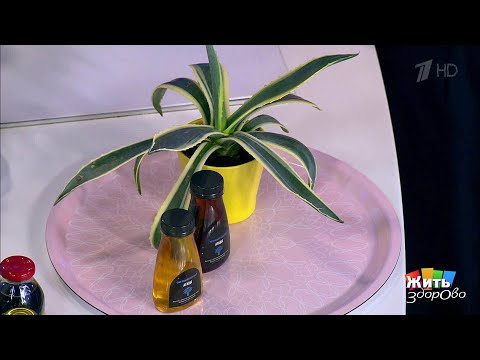

Watch this video on YouTube

